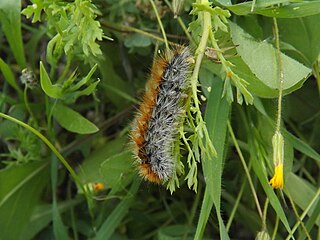
The Pyraloidea are a moth superfamily containing about 16,000 described species worldwide, and probably at least as many more remain to be described. They are generally fairly small moths, and as such, they have been traditionally associated with the paraphyletic Microlepidoptera.

The Lasiocampidae are a family of moths also known as eggars, tent caterpillars, snout moths, or lappet moths. Over 2,000 species occur worldwide, and probably not all have been named or studied. It is the sole family in superfamily Lasiocampoidea.

The Coleophoridae are a family of small moths, belonging to the huge superfamily Gelechioidea. Collectively known as case-bearers, casebearing moths or case moths, this family is represented on all continents, but the majority are found in temperate areas of the Northern Hemisphere. They are most common in the Palearctic, and rare in sub-Saharan Africa, South America, and Australia; consequently, they probably originated in northern Eurasia. They are relatively common in houses, they seek out moist areas to rest and procreate.

Gracillariidae is an important family of insects in the order Lepidoptera and the principal family of leaf miners that includes several economic, horticultural or recently invasive pest species such as the horse-chestnut leaf miner, Cameraria ohridella.

Nepticulidae is a family of very small moths with a worldwide distribution. They are characterised by eyecaps over the eyes. These pigmy moths or midget moths, as they are commonly known, include the smallest of all living moths, with a wingspan that can be as little as 3 mm in the case of the European pigmy sorrel moth, but more usually 3.5–10 mm. The wings of adult moths are narrow and lanceolate, sometimes with metallic markings, and with the venation very simplified compared to most other moths.

The striped field mouse is a rodent in the family Muridae. The range of this species stretches from Eastern Europe to Eastern Asia.

The Calpinae are a subfamily of moths in the family Erebidae described by Jean Baptiste Boisduval in 1840. This subfamily includes many species of moths that have a pointed and barbed proboscis adapted to piercing the skins of fruit to feed on juice, and in the case of the several Calyptra species of vampire moths, to piercing the skins of mammals to feed on blood. The subfamily contains some large moths with wingspans longer than 5 cm (2 in).

The herald is a moth of the family Erebidae. The species was first described by Carl Linnaeus in his 1758 10th edition of Systema Naturae. It is found throughout the Palearctic and Nearctic (Holarctic).

The white-bellied fat-tailed mouse opossum is a species of opossum in the family Didelphidae. It is found in Argentina, Bolivia, Chile and Peru.

Tate's fat-tailed mouse opossum is a species of opossum in the family Didelphidae, named after American zoologist George Henry Hamilton Tate. It is found at elevations of 300 to 3,000 m along the coast of central Peru. The species has the northernmost range of any member of its genus. It has white ventral fur and short condylobasal and zygomatic lengths. T. pallidior is very similar.
Eremochlaena is a genus of moths of the family Noctuidae, first described by Charles Boursin in 1953. The type species is Eremochlaena oranaLucas, 1849.

Palpidia is a genus of moths in the family Erebidae. The genus was erected by Harrison Gray Dyar Jr. in 1898.

Batrachedra praeangusta is a moth of the family Batrachedridae which is native to Europe. It is also found in North America. It was first described by Adrian Haworth in 1828 from the type specimen found in England. The foodplants of the larvae are poplars and willows.
Sympistis figurata is a moth of the family Noctuidae first described by Leon F. Harvey in 1875. It is found in the United States east of the Cascade Range in Washington and Oregon.

Orthosia gracilis, the powdered Quaker, is a moth of the family Noctuidae. It is found in all of Europe except the extreme north and south, then east across the Palearctic to Northern Asia and Central Asia. O. g. pallidior is described from Xinjiang in China.

Palpidia melanotricha is a species of moth in the family Erebidae. The species is found in Jamaica.
Byrsia dotata is a moth of the family Erebidae. It was described by Francis Walker in 1865. It is found on Sulawesi, Ambon Island, Batchian, Timor and New Guinea.

Ocnogyna loewii is a moth of the family Erebidae. It was described by Philipp Christoph Zeller in 1846. It is found in Asia Minor, Cyprus, Near East, Armenia, Azerbaijan, Daghestan, southern Uzbekistan, south-western Tajikistan, northern Iran and Afghanistan.

The Scolecocampinae are a subfamily of moths in the family Erebidae. The taxon was erected by Augustus Radcliffe Grote in 1883.
Agonopterix pallidior is a moth in the family Depressariidae. It was described by Stringer in 1930. It is found in Japan and the Russian Far East.














